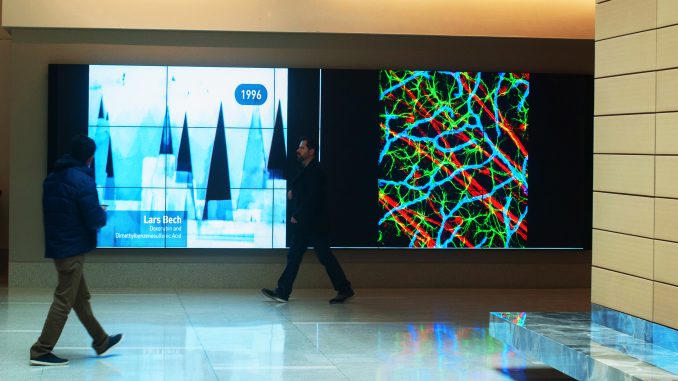
Jens H. Petersen (left) submitted a scarlet pimpernel macrograph to the Wistar Institute for Nikon Small World Photomicrography Competition, and Dr. Sabrina Kaul submitted a larval stage development of an acorn worm. | Allan Barnes TTN
Amidst the transparent glass walls and doors, up the wide white staircase and echoing throughout The Wistar Institute atrium is a world only visible through the refracted lens of a microscope.
Twenty selected discoveries reveal the close-up photos sought after in the 2014 Nikon Small World Photomicrography Competition.
Located on 36th and Spruce streets, The Wistar Institute is currently hosting the Nikon Small World Exhibit, a display of the Top 20 winners from the annual Photomicrography Competition.
“It’s not so much about what the subject is but it’s about looking at it in a different way people haven’t seen and sort of exploring it, bringing out something that’s unique and eye-catching,” James Hayden, managing director of Imaging Shared Resources at The Wistar Institute, said.
In its 40th year of the competition, Nikon received more than 1,200 entries from 79 countries. The competition focuses on four components for the judging criteria: visual impact, originality, information content and technical proficiency. The winning images contrast each year among the four elements, accelerating the fusion of science and art.
“There’s been a shift over the years toward more high visual impact images, away from the scientific content and technical proficiency,” Hayden said.
The 2014 first-place winner Rogelio Moreno, a Panamanian computer system programmer, purchased his equipment from eBay.
“When you get some new, fresh person coming in looking at it with a new, fresh way, you wind up getting some really neat images that you wouldn’t have thought of necessarily,” Hayden said.
Another competitor, Lars Bech, submitted entries consistently until his death in 2011. He was a minister in the Netherlands and his work is often referenced as a reflection of painters like Vincent van Gogh and Paul Klee.
“The appeal is the images,” said Darien Sutton, senior media relations associate at The Wistar Institute. “Some of them could be other things that if you were to look at them once, you might think that that’s Van Gogh’s painting of “Starry Night.” But it’s actually fluid flow around a coral,” Sutton said.
Photomicrography produces images of still-motion and intense magnification.
“You get sort of this dichotomous idea of what it is you’re looking at,” Hayden said. “And you can look at it on a couple of different levels. From the scientific point of view [or] you can look at it from an artistic point of view.”
The technical training for certain microscopes amounts to approximately nine hours. However, experience does not matter for the competition.
“When you have one that works you know it,” Hayden said. “You’re working on something for a while and you keep trying, you keep trying, you keep trying and – eureka.”
Framed images of the 20 winners will remain on display until March 6.
“We all have eyes and we all see things through the scope,” Hayden said. “If you can capture it.”
Allison Merchant can be reached at allison.merchant@temple.edu


Be the first to comment